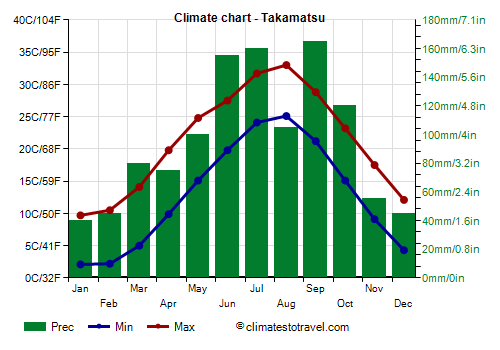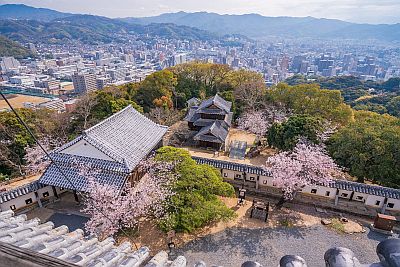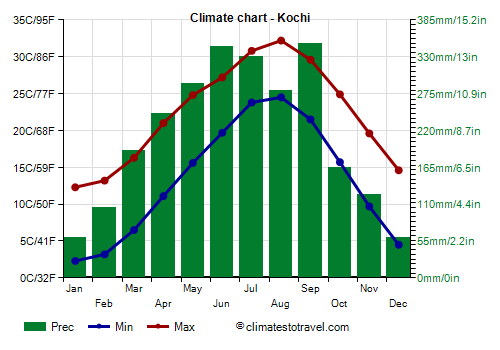Select units of measurement for the temperature and rainfall tables (metric or imperial).
Average weather, temperature, rainfall, sunshine hours
In Shikoku, the smallest of the main islands of Japan, the climate is
temperate, at least on the coasts, quite similar to that of the south side of Honshu: the winters are quite mild, and the summers are hot, muggy and rainy. According to the Köppen classification, the climate on the coasts is humid subtropical (Cfa).
Like the rest of Japan, the island is affected by the
monsoon circulation: in winter, the northwest cold currents prevail, while in summer, they are replaced by hot and humid currents of tropical origin.
The northern coast, facing the
Seto Inland Sea, is a little colder in winter than the southern coast, and definitely less rainy.
Snow in the plains is very rare everywhere, however, it can occasionally snow, even more easily on the south coast than on the north coast. For example, at the end of December 2022, 14 centimeters (5.5 inches) of snow fell in Kochi, on the south coast, and 10 cm (3.9 in) in Tokushima, on the northeast coast, while it did not snow in Takamatsu, on the north coast.
During
cold waves, the temperature at night does not drop much, as it usually only drops a few degrees below freezing.
In summer, during
heat waves, the temperature can reach 36/37 °C (97/99 °F).
Takamatsu

Here are the average temperatures in Takamatsu, on the north coast.
Takamatsu - Average temperatures (1991-2020) |
| Month | Min | Max | Mean |
|---|
| January | 2.1 | 9.7 | 5.9 |
|---|
| February | 2.2 | 10.5 | 6.4 |
|---|
| March | 5 | 14.1 | 9.6 |
|---|
| April | 9.9 | 19.8 | 14.8 |
|---|
| May | 15.1 | 24.8 | 20 |
|---|
| June | 19.8 | 27.5 | 23.6 |
|---|
| July | 24.1 | 31.7 | 27.9 |
|---|
| August | 25.1 | 33 | 29 |
|---|
| September | 21.2 | 28.8 | 25 |
|---|
| October | 15.1 | 23.2 | 19.2 |
|---|
| November | 9.1 | 17.5 | 13.3 |
|---|
| December | 4.3 | 12.1 | 8.2 |
|---|
| Year | 12.8 | 21.1 | 16.9 |
|---|
As for the rains, as mentioned, there is a clear difference between the two sides. The north side has a dry winter, and the annual rainfall is not very high, in fact it's around 1,150 mm (45 in) per year in Takamatsu, 1,200 mm (47 in) in Maragume, and 1,400 mm (55 in) in
Matsuyama (the main city on the island).
Here is the average rainfall in Takamatsu.
Takamatsu - Average precipitation| Month | Days |
|---|
| January | 39 | 6 |
|---|
| February | 46 | 7 |
|---|
| March | 81 | 9 |
|---|
| April | 75 | 9 |
|---|
| May | 101 | 8 |
|---|
| June | 153 | 10 |
|---|
| July | 160 | 9 |
|---|
| August | 106 | 7 |
|---|
| September | 167 | 9 |
|---|
| October | 120 | 8 |
|---|
| November | 55 | 6 |
|---|
| December | 47 | 6 |
|---|
| Year | 1150 | 96 |
|---|
On Shikoku Island, the sea is quite mild even in winter, although not for swimming, while it becomes pleasantly warm from July to September.
Takamatsu - Sea temperature| Month |
|---|
| January | 16.5 |
|---|
| February | 15 |
|---|
| March | 15 |
|---|
| April | 16.5 |
|---|
| May | 19 |
|---|
| June | 22 |
|---|
| July | 25.5 |
|---|
| August | 27.5 |
|---|
| September | 26 |
|---|
| October | 23.5 |
|---|
| November | 21"> |
|---|
| December | 18.5 |
|---|
| Year | 20.6 |
|---|

Kochi

In Kochi, on the southern coast, the winter temperatures are slightly higher, and the January average is 7 °C (45 °F).
Kochi - Average temperatures (1991-2020) |
| Month | Min | Max | Mean |
|---|
| January | 2.1 | 12.2 | 7.2 |
|---|
| February | 3.1 | 13.2 | 8.2 |
|---|
| March | 6.4 | 16.3 | 11.4 |
|---|
| April | 10.9 | 20.9 | 15.9 |
|---|
| May | 15.5 | 24.8 | 20.2 |
|---|
| June | 19.7 | 27.1 | 23.4 |
|---|
| July | 23.9 | 30.8 | 27.4 |
|---|
| August | 24.5 | 32.1 | 28.3 |
|---|
| September | 21.4 | 29.5 | 25.4 |
|---|
| October | 15.6 | 25 | 20.3 |
|---|
| November | 9.7 | 19.6 | 14.6 |
|---|
| December | 4.2 | 14.4 | 9.3 |
|---|
| Year | 13.1 | 22.2 | 17.65 |
|---|
The south side is decidedly more rainy: in Kochi, 2,650 mm (105 in) of rain fall per year, and the rains are very abundant from April to October. However, here the winter is a relatively dry season too.
Kochi - Average precipitation| Month | Days |
|---|
| January | 59 | 5 |
|---|
| February | 108 | 7 |
|---|
| March | 175 | 10 |
|---|
| April | 225 | 10 |
|---|
| May | 280 | 10 |
|---|
| June | 360 | 14 |
|---|
| July | 357 | 13 |
|---|
| August | 284 | 12 |
|---|
| September | 398 | 12 |
|---|
| October | 208 | 8 |
|---|
| November | 130 | 7 |
|---|
| December | 83 | 6 |
|---|
| Year | 2665 | 112 |
|---|
On the southern coast, the sea is also a little milder in winter than on the north coast.
Kochi - Sea temperature| Month |
|---|
| January | 18 |
|---|
| February | 17 |
|---|
| March | 17 |
|---|
| April | 18 |
|---|
| May | 20 |
|---|
| June | 23 |
|---|
| July | 26 |
|---|
| August | 27.5 |
|---|
| September | 26.5 |
|---|
| October | 24.5 |
|---|
| November | 22"> |
|---|
| December | 20 |
|---|
| Year | 21.7 |
|---|
In the
mountainous area that divides the two sides of Shikoku, the temperature decreases, even though at the same altitude it is not as cold as in the center-north of Honshu. The highest peak is Mount Ishizuchi, 1,982 meters (6,503 feet).
Here are the average temperatures of Mount Tsurugi, 1,955 meters (6,413 ft) high.
Tsurugi - Average temperatures (1961-1990) |
| Month | Min | Max | Mean |
|---|
| January | -10.3 | -4.1 | -7.2 |
|---|
| February | -9.9 | -3.1 | -6.5 |
|---|
| March | -6.9 | 0.5 | -3.2 |
|---|
| April | -0.3 | 7.1 | 3.4 |
|---|
| May | 4.3 | 11.4 | 7.8 |
|---|
| June | 8.6 | 14.4 | 11.5 |
|---|
| July | 12.9 | 17.9 | 15.4 |
|---|
| August | 13.2 | 18.2 | 15.7 |
|---|
| September | 9.6 | 15.2 | 12.4 |
|---|
| October | 3.3 | 9.8 | 6.6 |
|---|
| November | -1.9 | 5 | 1.6 |
|---|
| December | -7.3 | -0.8 | -4 |
|---|
| Year | 1.3 | 7.7 | 4.5 |
|---|
Precipitation in the mountains is even more abundant than on the southern coast. On Mount Tsurugi, it amounts to 3,370 mm (132 in) per year, and in winter it usually occurs as snow.
Tsurugi - Average precipitation| Month | Days |
|---|
| January | 126 | 17 |
|---|
| February | 147 | 15 |
|---|
| March | 208 | 17 |
|---|
| April | 211 | 13 |
|---|
| May | 278 | 13 |
|---|
| June | 463 | 16 |
|---|
| July | 435 | 16 |
|---|
| August | 517 | 16 |
|---|
| September | 533 | 16 |
|---|
| October | 224 | 12 |
|---|
| November | 139 | 10 |
|---|
| December | 91 | 13 |
|---|
| Year | 3370 | 172 |
|---|
Like the rest of Japan, from June to October (but especially from August to early October), the island of Shikoku can be hit by
typhoons, the tropical cyclones of the western Pacific. The areas most at risk are the mountainous area, where heavy rains can cause floods and landslides, and the southern coast, more exposed to wind and storm surges.
The
cherry blossoming in Shikoku, at least in the lowlands, normally occurs from late March to early April.